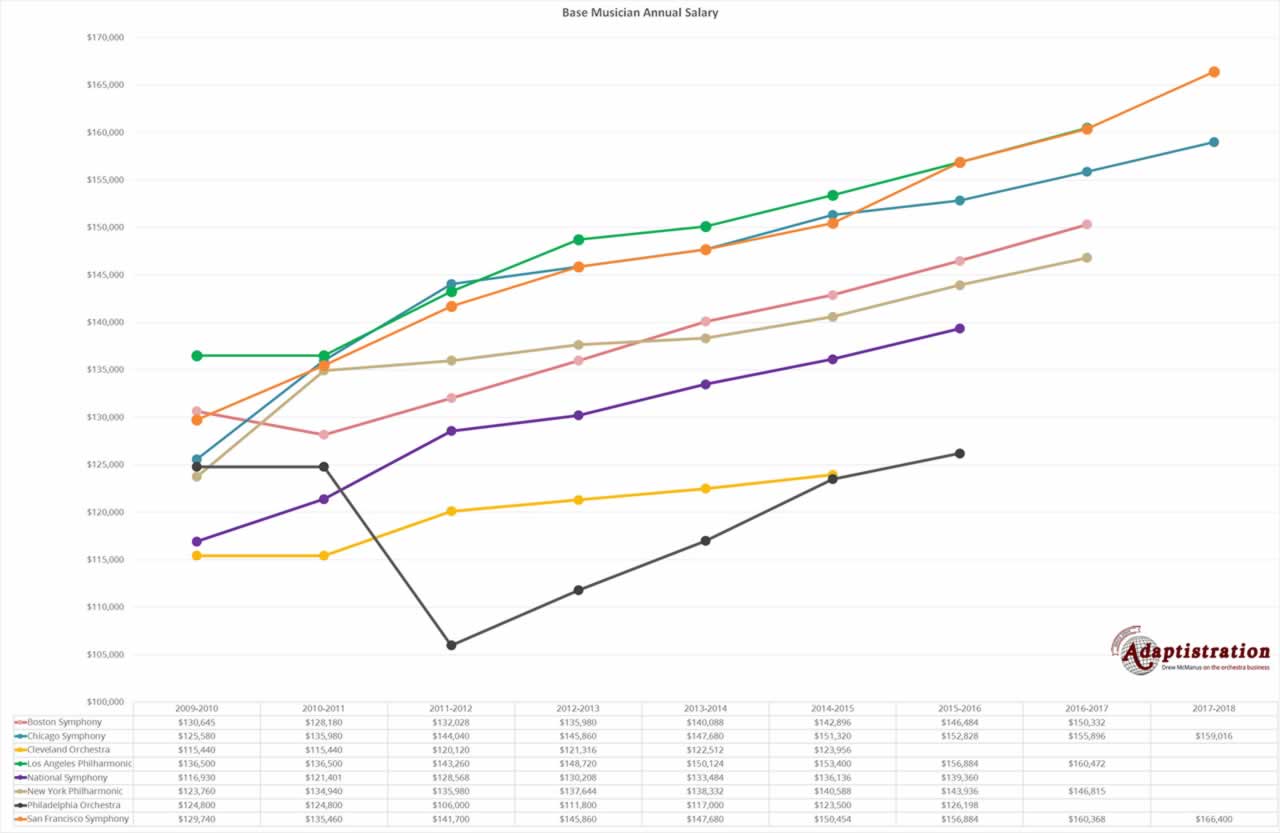In a recent blog post, Washington Post music critic, Ann Midgette, posed questions concerning:
- what influence a hall’s acoustic response has on orchestral performance technique, and
- what effect the 1997 renovation of the Kennedy Center Concert Hall had in improving acoustics onstage and in the audience.
In response to the first, I can report conclusively that orchestras have great flexibility in adapting their playing to different environments. I offer a few anecdotal observations here supporting this contention and also comment on the effect of recent acoustical adjustments at Kennedy Center Concert Hall…
Nashville Symphony (Tennessee Performing Arts Center/Schermerhorn Symphony Center*)
 Prior to moving to moving to the new Schermerhorn Symphony Center, the Nashville Symphony performed in the multi-purpose Tennessee Performing Arts Center. The farther the musicians were seated behind the proscenium of that facility, the more forceful they had to play to make an impact in the room.
Prior to moving to moving to the new Schermerhorn Symphony Center, the Nashville Symphony performed in the multi-purpose Tennessee Performing Arts Center. The farther the musicians were seated behind the proscenium of that facility, the more forceful they had to play to make an impact in the room.
Particularly affected were brass and percussion sections. As they played louder, other musicians became concerned about their hearing. These sections were pushed further back (the seating area for the orchestra became very large), and a forest of plexi-glas shields appeared.
In moving to their new home, in which all the musicians play within the audience chamber, the players had to learn a new way of listening and responding to the lively new acoustics. The brass, in particular, quickly learned to temper their efforts, and despite the much smaller seating area provided to the orchestra (better for ensemble) the plexi-glas shields have largely disappeared.
Indianapolis Symphony (Hilbert Circle Theater*)
Because of its relatively small cubic volume for the number of seats in the room, the Hilbert Circle Theater in Indianapolis employs an electronic enhancement system to extend the reverberation time in the room. The effect is subtle and many don’t know this system is even there. When music critic Bernard Holland visited the room for a concert shortly after a new orchestral shell was installed and the enhancement system returned, he praised the acoustic virtues of this room and small rooms in general without realizing that some electronic “reflections” had been added.
When new Music Director, Mario Venzago, arrived the following year, he expressed some concerns about the sound of the orchestra and wondered if the enhancement system was performing properly. So we conducted a little experiment.
With my partner Paul Scarbrough listening in the balcony with the maestro, I conducted the orchestra in several excerpts. The excerpts were repeated for alternate settings of the enhancement system. In the end, Venzago determined that our original setting was the best one, and if adjustments were to be made they would need to be made elsewhere. That is when the real fun began.
Using the excerpts, Mario, still in the balcony, would ask to hear orchestral sections individually, suggesting different articulations and timbral effects. In Beethoven 5th, 2nd movement, for example, the trumpets at one point were asked to play a little bit shorter, darker… woodwinds a little longer,…cellos and basses more articulated. In the space of 1-1/2 hours we disassembled the orchestral old playing habits, and created a new approach, covering a variety of repertoire.
This exercise was so efficient that, later, I asked Mario to work with us in a similar effort to help the Nashville Symphony learn to adjust its playing to its new home. He did this, charging no fee.
Vienna Philharmonic (Vienna Musikvereinssaal)
This hall is revered, considered by many to be the best, but if you play in it too aggressively the result will usually not sound good. A tuba player in the Vienna Philharmonic once described his playing technique as “giving the room a nudge”. Brass from touring orchestras coming from halls where they play far behind the proscenium (and feel they must force to be heard) need to become aware of this tip…quickly.
Philadelphia Orchestra (Academy of Music)
Perhaps the most famous example of an orchestra’s adaptation to its home is that of the Philadelphia Orchestra under Stokowski and, later, Ormandy, performing in the Academy of Music. The Academy has very dry acoustics, very clear. The lush sound of the strings developed in that era, with Stokowski’s innovation of free bowing to feather attacks and releases (the string section effectively creating its own reverberation) was a response to this environment.
My first listening experience at Disney Hall with the Los Angeles Philharmonic included a performance of Schumann’s 2nd Symphony under the direction of Christof von Dochnanyi . Like the Academy of Music, Disney has exceptionally clear acoustics, so clear that sometimes individual string players in a section can be identified. In the slow movement of the Schumann, Dochnanyi asked the strings for free bowing, a la Philadelphia. The sound of the string section was immediately transformed into something considerably more lush and sensuous than was present at other points in the program.
National Symphony Orchestra (Kennedy Center Concert Hall*)
The 1997 renovations in this hall included a new stage enclosure with adjustable acoustic canopy, addition of a concert organ, and removal of half of the topmost side tier. The removal of the side tier elements was particularly important because it created an acoustic “hard-cap” (zone with little acoustic absorption) in the hall where none existed before. Sound from the orchestra energizes this zone where sound dies slowly and, consequently, lengthens the reverberation time of the room. The improvements to the sound in the hall and onstage were enthusiastically reported by the press at the re-opening.
I first heard the results of the renovation a few years later and the reverberation and a sense of sonic envelopment in the room was clearly evident. A more recent visit was disappointing, however. I heard less reverberation and the orchestra sounded a bit harsh and directional. Looking at the stage I noticed that the acoustic canopy was positioned several feet lower than the first time I attended. The effect of lowering the canopy not only makes the early energy in the room louder (masking later reverberation), but also provides a partial barrier to sound energy reaching the hard-cap. Less energy there means weaker reverberation.
Draw your own conclusions. End of class.
* In interest of full disclosure, my firm, Akustiks, was the acoustical consultant for both Schermerhorn and Hilbert Circle Theater examples. Also, Akustiks partner, Paul Scarbrough, was principal designer for the renovation of the Kennedy Center Concert Hall when he was at a Principal at Jaffe Holden Scarbrough. (But he was not responsible for recent lowering of the canopy). We are all too young to have designed the 1911 major renovation of the Musikvereinssaal or creation of the Academy of Music in 1857.



I was thinking of you about ten days ago when I heard the Berkeley Symphony Orchestra in the electronically-enhanced Zellerbach, which is highly problematic.
My limited experience of Dohnanyi (a magnificent performance of Arabella at Covent Garden) is that his personal sound emphasizes clarity and balance, so I wonder how that interacted with Disney. My less limited experience of Disney is that it has considerable warmth as well as clarity.
Hi Lisa-
Arabella should always sound clear and balanced. Of course this becomes much easier to accomplish when the orchestra players faithfully execute Strauss’ finely-tuned dynamic markings. You might be surprised how many don’t and get a little “carried away”.
I am curious: Where do you usually sit at Disney? Do you have a favorite section? I have sat in five different parts of the hall thus far (haven’t tried the upper balcony yet) and the sound is very different at each location.
-Chris
Ha, yes, on the ideal sound of Arabella. Conductors also have some responsibility in that area.
I have sat in Disney in Orchestra East, which is on one of the long walls, and in the Terrace. I’ve heard both chamber music and the orchestra from Orch. East, full orchestra only from the Terrace.
Any thoughts on Zellerbach?
“Conductors have some responsibility in that area”
Wonderful!!
Getting carried away seems to be part of the conductor’s job description in some quarters. However, watching Strauss conduct his pieces (not to mention his published admonitions to young conductors) gives a clue as to what is really necessary.
I have also sat in Orchestra East at Disney and I think these are among the best seats. What are your thoughts about the Terrace in comparison?
I am sorry to say that I am totally unfamiliar with Zellerback (and its enhancement system.)
Ah, too bad – I need to find an acoustician who knows the hall.
I heard a program that included a Sibelius symphony and Salonen’s Wing on Wing from the Terrace, and I remember that amazing clarity of sound very well, also how audible everything was. The two sopranos in the Salonen sing from different locations in the hall and at one point, I heard their footsteps on the stairs quite clearly even though they were far away. So I guess you could say I did not hear an appreciable difference between the Terrace and Orchestra East. The only problem I heard in the hall was a very slight echo when I was in Orch. East and there was some bounce from the winds at the far side of the orchestra from me. However, it was minor compared to the amount of bounce when you’re near the walls in the orchestra seating of War Memorial Opera House. That is pretty distracting.
While I don’t know Zellerback, I did some digging and do know now that the new enhancement design includes the “Constellation” system by Meyer Sound. So that might be a good place to start with your inquiries.
My company worked with the predecessor of this system (before the design was acquired by Meyer) at the Plaza Theater in El Paso, TX. My experience there was that the system, once it was electronically balanced in the room by the manufacturer, required further adjustment with orchestra to achieve the best results. Whether this fine tuning was done at Zellerback, I don’t really know.
Thanks for the listening input on your seating locations in Disney.
Having lived in Vienna for years, I can’t say I agree with the characterization of the Musikverein. Warm yes, but but not the easily overwhelmed jewel box that folks make it out to be. I heard several orchestras, including Minnesota and Berlin, simply not project enough to make an impact. Vienna’s power is unmatched, and the strings really dig in. If this is “aggressive” playing, i’d say it actually works better in the Musikverein than in other halls, since the long reverberation time smooths over the rough edges. How the audience perceives the sound is very different from on stage. Having heard NSO at Schermerhorn, the brass sound simply underpowered and tepid, or like they could “force” a lot more. In any large hall, an orchestra must work to project, or the effect will be underwhelming. The idea that you can just “give the room a nudge” might hold true for tuba, but no one else.